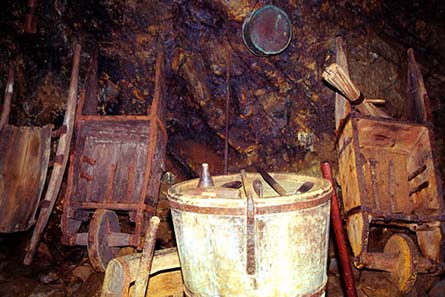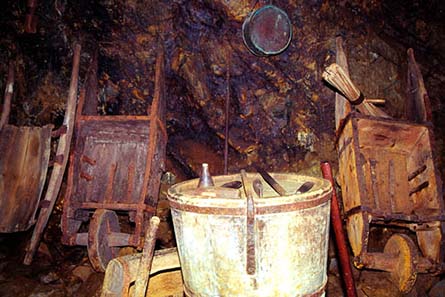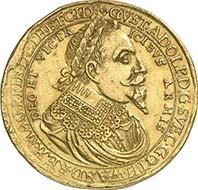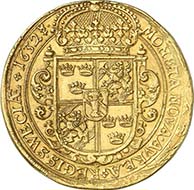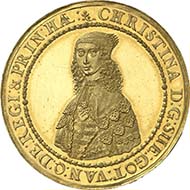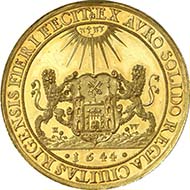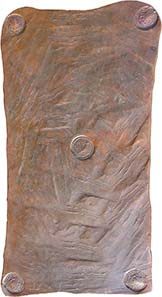A Nordic heavy weight: the second heaviest coin of Classical numismatics
by courtesy of auction house Fritz Rudolf Künker
Almost 15 kilograms, as much as 4 bricks – that is the weight of the second heaviest coin of Classical numismatics, this Swedish copper plate of 8 taler. It was issued in 1659.
Tourist mine at Falun. Source: Wikipedia.
The problem
In the 17th century, it was Sweden where Europe’s most important copper mines were located. The yields of the Falun mine met two thirds of the European needs of that strategic material. Copper was required for the production of bronze of which canons and muskets were made. The rich deposits in Sweden significantly contributed to that country becoming the dominant power in Northern Europe in that martial 17th century.
On the other hand, Sweden lacked almost entirely silver. But that metal was likewise needed – to pay the mercenary soldiers as well as in association with diplomacy.
Hence, the Swedish King Gustav Adolph was faced with the question as to how to get as much silver as possible out of the copper deposits. The merchants in Amsterdam, where Sweden marketed its copper, paid less money the more metal the King had sent. The price, so the experts explained, would rise if the amount of delivered copper decreased. Sweden controlling the market, it would be easy to artificially create a shortage. But that would mean on the other hand, that, for a short period of time, the supply of silver decreased as well resulting in a break-down of Sweden’s supply with silver coins.
MAINZ. 8 ducats 1632. Of utmost rarity. Extremely fine. Estimated at 30,000 Euros. From the upcoming sale Künker 185 (2011), 6035. – The currency reform being history for half a century, Sweden felt strong enough to defend its own interest in the Thirty Years’ War…
The solution
The easiest solution seemed to be obvious: why not use the copper that was hitherto sent to Amsterdam as basic material for the production of coins? With small change, that had become common practice since antiquity. Hence, in 1624 the first edition of 2, 1, and 1/2 öre coins made of copper was issued. This pieces’ weight was balanced to the effect that the metal value corresponded to the nominal value. The Swedish king, therefore, had all options. As long as he was not happy with the Amsterdam copper price the coins would circulate in Sweden. If, on the other hand, the price rose considerably the copper coins would be changed for silver ones and the copper gained by that would be sold in Amsterdam.
The outcome
In 1625, already 26% of the annual copper production was used for the coin production. The Swedish government had a vast number of these coins issued. Unfortunately, in doing so, it was anything but lucky. Enterprising Swedes would hit on the idea to privately buy copper coins and offer them on the metal market if only the price for copper was high enough. In case the silver price was high, in contrast, copper could only be exchanged to silver with a significant premium, which was very unpopular among the Swedish citizens.
RIGA. 6 ducats 1644. Of utmost rarity, extremely fine to brilliant uncirculated. Estimated at 30,000 Euros. From the upcoming sale Künker 185 (2011), 6059. – Since 1621 Riga had formed part of the Swedish empire. The ship our plate money came from was transporting Swedish currency to Riga.
A second try
Since 1640, the High Council discussed the introduction of copper plates as currency for bigger transactions. By then, Christina had succeeded her father to the Swedish throne and Swedish troops continued to be engaged in the seemingly ever-lasting religious war in Germany.
Silver was still scarce and copper available in abundance. So, why use copper for the production of öre only and not for daler as well? For that purpose, circular patterns with a diameter of 22 cm and a weight of more than three kilograms worth 1 1/2 daler were made. The production costs, however, were high, too high, so that a member of the Council hit the idea to make coins from the plates which had been produced of the Falun copper for centuries. These plate coins could be used either as ingots or as coins, as required.
In 1644, that idea was put into practice. It was decided that 10 daler ought to equate 19.72 kilograms. As is known from reports, the High Council thought that measure still portable”. We know of 26,539 of these 10 daler plates being issued. We did not have any of these plates until 1974. The reason for the Swedish plate money being that rare is the circumstance that it was melted down as soon as the copper price exceeded the nominal value, which occurred quite often. In 1974, however, five specimens of this first edition were discovered in a shipwreck near the Baltic coast.
Copper plate of 8 daler silvermynt 1659, Avesta. Of utmost rarity. Very attractive, extremely fine specimen with fine patina. Estimated at 75,000 Euros. From the upcoming sale Künker 185 (2011), 6001.
Our example, an 8 daler plate
Our example, too, comes from a ship wreck discovered in the early 20th century at the entrance of the port of Riga. The majority of the found 8 daler plates are housed today in museums, and some few pieces were sold by the Russian authorities to private collectors.
Our plate money was created in 1659 under King Charles X Gustav. His original idea was to market the annual copper yield via a French syndicate. In order to kick-start negotiations the king had ordered in 1655 to cease issuing plate money. The arrangement, however, did not materialize – hence, the production continued. Charles X Gustav did want to do without that relief to the treasury. After all, he was engaged in more than one war. In the year our piece was coined the Swedish troops fought in the so-called Little Northern War in Poland.
The plate money of 8 daler weighs 14.6 kilograms – in accordance with the coin edict of 1649, each daler added with 1.812 g. The size is remarkable, too. It measures 34 x 62.5 cm. In the center a circular stamp with the value declaration can be seen, in the corners circular stamps with the crown and the date.
The end of the plate money
The production of 10 daler plates already halted in 1646, and in 1682 the coinage of 8 daler plates likewise came to an end. Copper plates, however, continued to be issued right into the 18th century. It was on January 1st, 1777, that the copper plates were withdrawn from circulation. Up to that day, more than 44,000 tons of Swedish copper had been coined.
The pieces shown here are all part of the collection of Julius Hagander who died in 2009. He was not only an important collector of Swedish coins but a significant patron of Swedish numismatics as well. His collection will be auctioned off by the coin and trading company Künker / Osnabruck on March 17, 2011.






